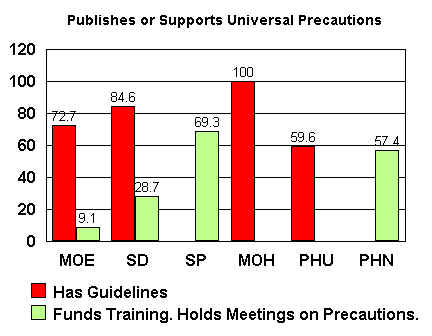
Policy - Universal Precautions to Prevent HIV
8.1.10 Policy - Universal Precautions to Prevent HIV
In the late 1980s, there was considerable activity in all jurisdictions on the precautions that should be taken within schools and other institutions to prevent the spread of HIV. The data below suggest that this activity has dropped off since that time.
Three-quarters (72.7%) of education ministries
(MOE-35) have published guidelines on taking these hygienic and safety precautions. 84.6% of school districts (SD-33) reported having such guidelines. 69.3% of school principals reported that they had reviewed these guidelines (SP-26).Figure 34

Figure 35
| Have Guidelines on Universal Precautions | Yes |
No |
Don’t Know |
No Response |
| MOE-35 | 72.7 |
27.3 |
0.0 |
0.0 |
| SD-33 | 84.6 |
5.2 |
10.2 |
0.0 |
| SP - 26 | 69.3 |
26.8 |
2.8 |
1.1 |
Training in Use of Hygienic Precautions
A small minority (9.1%) of education ministries reported
(MOE-37) that they regularly funded or supported staff training in the universal precautions. 28.7% of school districts reported (SD-35) that they regularly fund staff training in the use of these precautions. About a quarter of school principals reported that their school staff were regularly trained in the these precautions.Figure 36
| Offer Training in Hygiene Precautions | Planned within next 2 years |
Regularly |
Once in last 3 yrs. |
Once in last 4-10 yrs. |
Never |
Not role |
No Response |
| MOE - 37 | 0.0 |
9.1 |
0.0 |
18.2 |
54.5 |
18.2 |
0.0 |
| SD - 35 | 1.8 |
28.7 |
17.8 |
13.8 |
26.8 |
n/a |
11.1 |
| SP - 28 | 0.0 |
27.7 |
33.0 |
6.8 |
30.0 |
2.5 |
0.0 |
The public health systems were also asked if they had published or supported universal hygiene precautions. Over half of health respondents at all levels said that they have published or used such guidelines. They replied as follows:
Figure 37
| Have Published Guidelines on Hygiene Precautions | Yes |
No |
Don’t Know |
No Response |
| MOH - 17a | 100.0 |
0.0 |
0.0 |
0.0 |
| PHU - 13a | 59.6 |
29.5 |
4.0 |
6.9 |
| PHN - 13a | 57.4 |
39.3 |
1.8 |
1.5 |